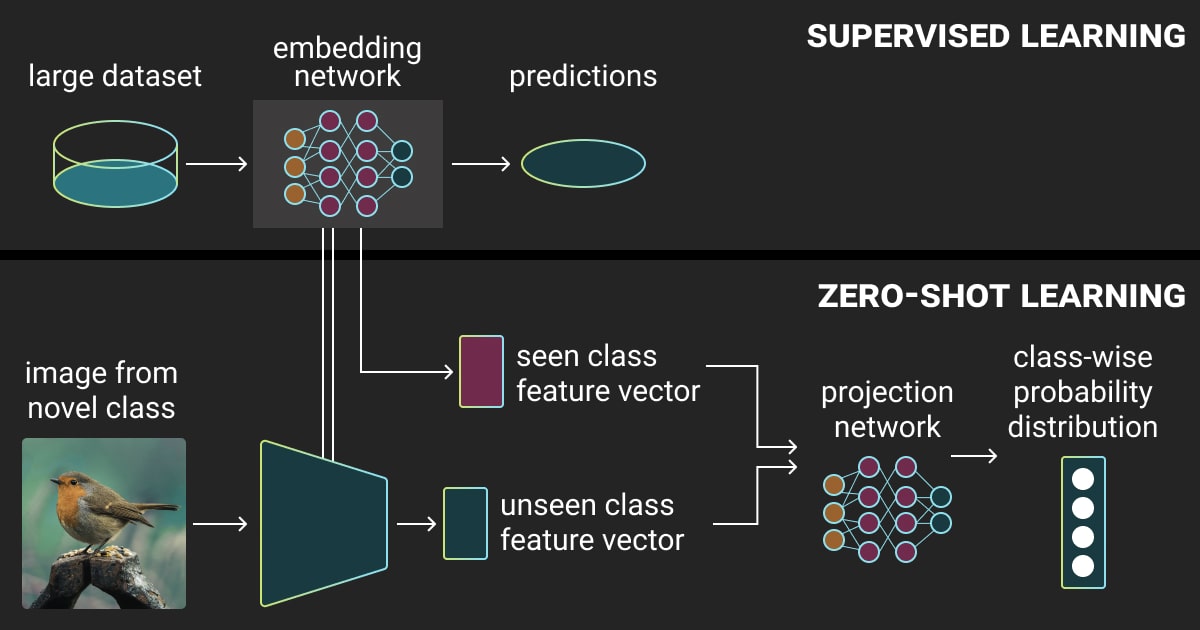
Zero-Shot Learning: How AI Thinks Like Humans Without Training
Imagine moving to a new country where you've never been before. You don’t speak the language, and you don’t know the local customs, yet you can still navigate your way through the city, understand that a red traffic light means stop, and even guess what’s on a restaurant menu based on images and familiar words.
This ability to make sense of new situations based on what you already know is similar to how Zero-Shot Learning (ZSL) works in artificial intelligence.
Traditional AI models need thousands of labeled examples to recognize new objects, translate languages, or categorize emails. But what if an AI could understand and classify something entirely new without any prior training data? That’s exactly what ZSL does.
How Zero-Shot Learning Works in Everyday Life
ZSL allows AI to handle new tasks without prior labeled training data, just like how humans apply their knowledge to unfamiliar situations. Let’s break this down with real-world examples:
- Learning a New Word in Context
Imagine a child who has never seen a giraffe before. If you tell them, "A giraffe is a tall animal with a long neck that eats leaves from trees," they can picture it in their mind. Even without ever seeing a giraffe, they now have enough context to recognize one in a picture book.
ZSL works similarly: It doesn’t need to see thousands of labeled giraffe photos. Instead, it uses descriptions (text data) and connects them to existing knowledge about animals.
- Identifying a New Dish on a Menu
Let’s say you’re traveling and come across a menu item called Rollex, which you’ve never heard of. However, the description says, "A Ugandan-based dish made by combining an egg omelette and vegetables wrapped in a chapati." Even without ever trying it, you now have a rough idea of what it might look and taste like.
An AI model using ZSL would do the same; it recognizes new categories based on descriptions rather than requiring thousands of past examples.
- Customer Support Without Predefined Responses
Ever chatted with a customer support chatbot? Normally, these bots are trained on specific questions like "How do I reset my password?" or "What are your refund policies?" But what if you ask something completely new, like "How do I change the delivery address for a package already in transit?"
A Zero-Shot Learning chatbot could understand the intent behind the question and match it to similar known topics without being explicitly trained on that exact phrase.
How Does Zero-Shot Learning Work?
ZSL relies on three main components:
Pre-trained Models – The AI is first trained on large amounts of general data (text, images, etc.), similar to how humans gather knowledge over time.
Extra Information (Attributes & Descriptions) – The AI uses contextual information, such as text descriptions, to understand new concepts.
Knowledge Transfer – The AI applies what it knows to new tasks by mapping concepts into a common space where relationships can be analyzed.
For example, if an AI model has learned about horses, zebras, and tigers, it can recognize a new animal - like an hyena - if given a description like "A muscular animal with sloping back and powerful front legs that are longer than its hind legs, with a sandy or golden coat with dark spots, or a grayish coat with black stripes."
Zero-Shot Learning vs. Few-Shot Learning
While Zero-Shot Learning works with no prior labeled examples, Few-Shot Learning (FSL) allows models to learn from just a few labeled examples.
Which one is better?
ZSL is ideal when labeled data isn’t available, such as recognizing new objects in images or detecting unknown cybersecurity threats.
FSL is better when a small number of labeled examples exist, like medical diagnosis where a few past cases can guide predictions.
Where Zero-Shot Learning is Used Today
- Text & Language Processing
Email spam filtering – Identifies spam based on descriptions rather than past examples.
Chatbots & virtual assistants – Understand new user queries without retraining.
Sentiment analysis – Detects whether a review is positive or negative, even for new products.
- Image Recognition
Object classification – Recognizes animals, foods, or cars using text descriptions.
Medical imaging – Identifies rare diseases based on doctor’s notes rather than labeled images.
- Retail & Recommendations
Product categorization – Assigns new products to the right categories without training data.
Cold-start recommendations – Suggests new products or movies based on descriptions.
The Challenges of Zero-Shot Learning
ZSL is powerful, but it isn’t perfect. Here are some common challenges:
-
Knowledge Representation Limitations – AI might struggle with subtle differences, like distinguishing a cheetah from a leopard if descriptions are vague.
-
Domain Gaps – If AI is trained on everyday images, it might not perform well in medical or scientific fields where data is very different.
-
Bias & Fairness – Pre-trained models can inherit biases from training data, affecting fairness in hiring, law enforcement, and finance.
-
Accuracy vs. Flexibility – ZSL is more flexible than traditional models but can be less precise. Hybrid models combining ZSL with fine-tuning are a solution.
A Future Without Data Constraints
Zero-Shot Learning is helping AI think more like humans by making connections between concepts rather than relying on large datasets. It allows models to be more flexible, reduces costs associated with data collection, and enables AI to tackle new challenges in real-time.
While challenges exist, improvements in knowledge representation, bias reduction, and hybrid learning models are making ZSL a critical technology in the future of artificial intelligence.
Whether it’s helping chatbots understand complex customer questions, recognizing rare diseases, or classifying new products in e-commerce, ZSL is reshaping how AI learns - without limits.












